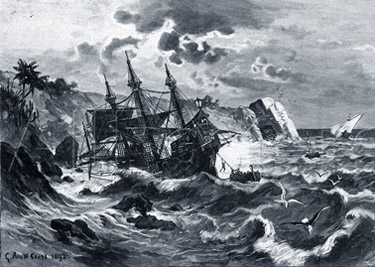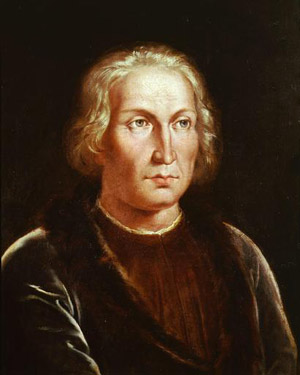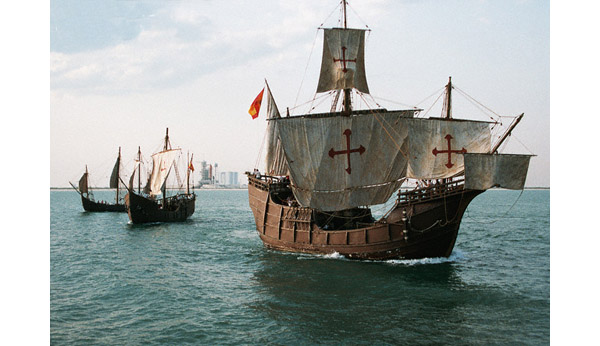 |
American History
Columbus and the
First Christmas in America
Margaret C. Galitzin
To people who go into a new country to live, Christmas, which is so generally a family feast, must of necessity be a lonely, homesick one. They carry with them the memory of happy customs, of loved ones far away, and of familiar customs. Most especially was this the case with the first Christmas spent by the Catholic Spanish explorers in the New World.
Since land had been sighted in October of 1492, Columbus had continued exploring the Bahamas, the northeast coast of Cuba and the northern coast of Hispaniola in the Caribbean. The intrepid mariner, Christopher Columbus, entered the port of Bohio, in the Island of Haiti, on St. Nicholas Day, December 6, 1492. In honor of the day, he named that port Saint Nicholas. The caravel
Pinta with its crew had parted from the other two ships and gone its own way, so the Santa Maria and the Niña sailed on together, occasionally stopping where the port seemed inviting. While in one of these, Columbus heard of rich mines not far distant and started out for them.

The grounding of the Santa Maria |
On the Santa Maria, the Admiral and his men were tired from continuously keeping watch, and as the sea was smooth and the wind favorable, they retired to their quarters below deck to sleep on Christmas Eve, leaving the ship in care of a boy. Instead of smooth sailing, however, the ship ran into trouble and struck a sand bank and settled, a complete wreck in those waters so close to land. Fortunately no lives were lost, and the wreckage furnished material for the building of a fortress. This task occupied the men's time during the remainder of the Christmas season.
The Niña was too small to accommodate two crews. Therefore, on Christmas Day many of the men were wondering who were to stay on that far-away island among the bizarre looking natives of whom they knew nothing.
Guacanagari, the chief of the nearby tribe, who had already heard about these strange men sailing the waters, sent many of his men in canoes to assist the strangers and did what he could to help them during the day. Spaniards and natives worked until dawn on Christmas morning to bring ashore what they could save from the wreckage and stored it away on the island for future use. Fortunately, they succeeded in saving almost all of their provisions, the spars and even many of the nails of the wrecked Santa Maria.
But what a difficult Christmas morning for Columbus and his men, stranded on an island far from home, among a strange people! There were no festivities to be observed by that sad, care-worn company of 300 Indians on that day. The following morning, however, chief Guacanagari visited the Niña and invited Columbus ashore, where a meal was prepared in his honor, the first public function attended by Columbus in America.
We can imagine that beautiful island, which to many probably seemed a paradise on earth, with tall trees waving their long fronds in the warm breeze and myriads of birds such as they had never seen filling the air with song. Columbus stood, attired in his full uniform, as it befitted him to be, beside his host who was dressed just in a shirt and a pair of gloves that Columbus had given him, with a coronet of gold on his head. The other Indian chieftains also with gold coronets moved about in nature's garb, among the more or less "thousand” who were present as guests. The meal consisted of shrimp, cassavi - the same as the native bread - and some of their nutritive roots. It was not a sumptuous repast although it may have been a bountiful one.

Christopher Columbus |
The work of building the fortress began at once. Within 10 days the Fortress of La Navidad (present day Môle-Saint-Nicolas) was completed. It stood on a hill and was surrounded with a broad, deep ditch for protection against natives and animals. This was planned to be the home of those Spaniards who would remained there, for, as mentioned before, the Niña was too small to host the crews of two ships. Nothing had been heard of the Pinta. Leaving provisions sufficient for one year, Columbus bade farewell to those 39 men whom he would never see again, and sailed to Spain on January 4, 1493 to report the news of his Discovery, which thenceforth would be called the New World.
What for Columbus seemed a cruel fate – losing the Santa Maria and leaving his men behind in that fortress - was actually the means of his bestowing a valuable gift to History. Had the Santa Maria not wrecked but continued her course in safety that Christmas Eve, the fortress of La Navidad or any European settlement probably would not have been founded in the New World on Columbus’ first voyage. So, although it was a sad, troubled Christmas for the Spanish adventurers, it proved memorable in the annals of America.
Four hundred years later, the anchor of the Santa Maria was discovered and brought to the United States to be one of its treasured exhibits at the great Columbian Exposition, where a descendant of Columbus was the honored guest of the Government.

Replicas of The Santa Maria, the Nina and the Pinta
|

Adapted from Mary Pringle and Clara Urann, Uletide in Many Lands ,
Boston: Lothrop, Lee & Shepard, 1916, Chapter 9
Posted November 26, 2011

Related Topics of Interest
 The First Thanksgivings Were Catholic The First Thanksgivings Were Catholic
 The Glorification of Christmas Through History The Glorification of Christmas Through History
 Mary of Agreda in America Mary of Agreda in America
 The Appeal of the Stones San Juan Capistrano The Appeal of the Stones San Juan Capistrano
 La Conquistadora: Our Country's Oldest Madonna La Conquistadora: Our Country's Oldest Madonna
 Ven. Antonio Margil of Jesus: Apostle of New Spain & Texas Ven. Antonio Margil of Jesus: Apostle of New Spain & Texas
 Our Lady of Bethlehem - Her Roots & Her Adventure in America Our Lady of Bethlehem - Her Roots & Her Adventure in America
 The Cabalgata of Christ the King The Cabalgata of Christ the King

Related Works of Interest
|
|
History | Home | Books | CDs | Search | Contact Us | Donate

© 2002-
Tradition in Action, Inc. All Rights Reserved
|
 |
|